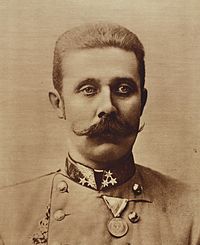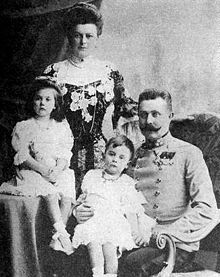This is an old revision of this page, as edited by Snowolf (talk | contribs) at 15:59, 19 December 2007 (Reverted edits by Cody 2410 (talk) to last version by Pooua). The present address (URL) is a permanent link to this revision, which may differ significantly from the current revision.
Revision as of 15:59, 19 December 2007 by Snowolf (talk | contribs) (Reverted edits by Cody 2410 (talk) to last version by Pooua)(diff) ← Previous revision | Latest revision (diff) | Newer revision → (diff)| This article needs additional citations for verification. Please help improve this article by adding citations to reliable sources. Unsourced material may be challenged and removed. Find sources: "Archduke Franz Ferdinand of Austria" – news · newspapers · books · scholar · JSTOR (November 2007) (Learn how and when to remove this message) |
| Archduke Franz Ferdinand of Austria | |
|---|---|
 | |
| Born | (1863-12-18)December 18, 1863 Graz, Austrian Empire |
| Died | June 28, 1914(1914-06-28) (aged 50) Sarajevo, Austria-Hungary |
| Title | Archduke of Austria-Este, Archduke of Austria, Prince Imperial of Austria, Prince Royal of Hungary and Bohemia |
| Spouse | Sophie, Duchess of Hohenberg |
| Children | Princess Sophie von Hohenberg, Maximilian, Duke of Hohenberg, Prince Ernst von Hohenberg |
| Parent(s) | Archduke Karl Ludwig of Austria and Princess Maria Annunciata of the Two Sicilies |
Franz Ferdinand, Archduke of Austria-Este (December 18, 1863 – June 28, 1914) was an Archduke of Austria, Prince Imperial of Austria, Prince Royal of Hungary and Bohemia, and from 1896 until his death, heir presumptive to the Austro-Hungarian throne. His assassination in Sarajevo precipitated the Austrian declaration of war. This caused countries allied with Austria-Hungary (the Central Powers) and countries allied with Serbia (the Entente Powers) to declare war on each other, starting World War I.
Birth and early life
Franz Ferdinand (Full Name: Franz Ferdinand Karl Belschwitz Ludwig Josef von Habsburg-Lothringen), was born in Graz, Austria, the eldest son of Archduke Karl Ludwig of Austria (younger brother of Emperor Franz Joseph and Maximilian I of Mexico) and of his second wife, Princess Maria Annunciata of the Two Sicilies. When he was only twelve years old, his cousin Duke Francis V of Modena died, naming Franz Ferdinand his heir on condition that he add the name Este to his own. Franz Ferdinand thus became one of the wealthiest men in Austria.
When he was born, there was no reason to think that Franz Ferdinand would ever be heir to the Austro-Hungarian throne. He was given the normal strict education of an archduke with an emphasis on history and moral character. From 1876 to 1885 his tutor was the historian Onno Klopp. In 1883 Franz Ferdinand entered the army with the rank of third lieutenant.
As a young man, Franz Ferdinand developed two great passions: hunting and travel. It is estimated that he shot more than 5,000 deer in his lifetime. In 1883, he visited Italy for the first time in order to see the properties left to him by Duke Francis V of Modena. In 1885, he visited Egypt, Palestine, Syria, and Turkey. In 1889, he visited Germany.
In 1889, Franz Ferdinand's life changed dramatically. His cousin Crown Prince Rudolf committed suicide at his hunting lodge in Mayerling, leaving Franz Ferdinand's father, Archduke Karl Ludwig, as first in line to the throne. However his father renounced his succession rights a few days after the Crown Prince's death. Henceforth, Franz Ferdinand was groomed to succeed.
Marriage and family

In 1895 Franz Ferdinand met Countess Sophie Chotek at a ball in Prague. To be an eligible marriage partner for a member of the House of Habsburg, one must be a member of one of the reigning or formerly reigning dynasties of Europe. The Choteks were not one of these families, although they did include among their ancestors, in the female line, princess of Baden, Hohenzollern-Hechingen, and Liechtenstein. Sophie was a lady-in-waiting to Archduchess Isabella, wife of Archduke Friedrich, Duke of Teschen. Franz Ferdinand began to visit Archduke Friedrich's villa in Pressburg (now Bratislava). Sophie wrote to Franz Ferdinand during his convalescence from tuberculosis when he went to the island of Lošinj in the Adriatic. They kept their relationship a secret for more than two years.
Archduchess Isabella assumed that Franz Ferdinand was enamored with one of her daughters. In 1898, however, he left his watch lying on a tennis court at her home. She opened the watch, expecting to find there a photograph of one of her daughters; instead, she found a photograph of Sophie. Sophie was immediately dismissed from her position.
Franz Ferdinand refused to consider marrying anyone else. Pope Leo XIII, Tsar Nicholas II of Russia, and the German Emperor Wilhelm II all made representations on Franz Ferdinand's behalf to the Emperor Franz Joseph of Austria, arguing that the disagreement between Franz Joseph and Franz Ferdinand was undermining the stability of the monarchy.
Finally, in 1899, the Emperor Franz Joseph agreed to permit Franz Ferdinand to marry Sophie, on condition that the marriage would be morganatic and that their descendants would not have succession rights to the throne. Sophie would not share her husband's rank, title, precedence, or privileges; as such, she would not normally appear in public beside him. She would not be allowed to ride in the royal carriage, or sit in the royal box.
The wedding took place on July 1, 1900, at Reichstadt (now Zákupy) in Bohemia; Franz Joseph did not attend the affair, nor did any archduke including Franz Ferdinand's brothers. The only members of the imperial family who were present were Franz Ferdinand's stepmother, Maria Theresia, and her two daughters. Upon the marriage, Sophie was given the title Princess of Hohenberg (Fürstin von Hohenberg) with the style Her Serene Highness (Ihre Durchlaucht). In 1909, she was given the more senior title Duchess of Hohenberg (Herzogin von Hohenberg) with the style Her Highness (Ihre Hoheit). This raised her status considerably, but she still took precedence at court after all the archduchesses. Whenever a function required the couple to gather with the other members of royalty, Sophie was forced to stand far down the line of importance, separated from her husband.
Franz Ferdinand's children were:
- Princess Sophie von Hohenberg (1901-1990), married Count Friedrich von Nostitz-Rieneck (1891-1973)
- Maximilian, Duke of Hohenberg (1902-1962), married Countess Elisabeth von Waldburg zu Wolfegg und Waldsee (1904-1993)
- Prince Ernst von Hohenberg (1904-1954), married Marie-Therese Wood (1910-1985)
- A stillborn son (1908)
Assassination
Main article: Assassination of Archduke Franz Ferdinand
On June 28, 1914, at approximately 11:00 am, Franz Ferdinand and his wife were killed in Sarajevo, the capital of the Austro-Hungarian province of Bosnia and Herzegovina, by Gavrilo Princip, a member of Young Bosnia and one of several (seven) assassins organized by The Black Hand (Црна рука/Tsrna Ruka). The event, known as the Assassination in Sarajevo, triggered World War I. Franz and Sophie had previously been attacked when a bomb was thrown at their car. It missed them, but many civilians were injured. Franz and Sophie both insisted on going to see all those injured at the hospital. As a result of this, Princip saw them and shot Sophie, in the abdomen. Franz was shot in the jugular and was still alive when witnesses arrived to his aid. Princip had used the Browning .380 ACP cartridge, a relatively low power round. The archduke's aides tried to undo his coat but by the time they realized they needed scissors to cut the coat open—Ferdinand had himself sewn in to appear slimmer—it was too late; he died within minutes. The assassinations, along with the arms race, nationalism, and the alliance system all contributed to the beginning of World War I, which began less than two months after Franz Ferdinand's death, with Austria-Hungary's declaration of war against Serbia.
Franz Ferdinand is interred with his wife Sophie in Artstetten Castle, Austria.
A detailed account of the shooting can be found in 'Sarajevo' by Joachim Remak
...one bullet pierced Franz Ferdinand's neck while the other pierced Sophie's abdomen.... As the car was reversing (to go back to the Governor's residence because the entourage thought the Imperial couple were unhurt) a thin streak of blood shot from the Archduke's mouth onto Count Harrach's right cheek (he was standing on the car's running board). Harrach drew out a handkerchief to still the gushing blood. The Duchess, seeing this, called: "For Heaven's sake! What happened to you?" and sank from her seat, her face falling between her husband's knees.
Harrach and Potoriek... thought she had fainted... only her husband seemed to have an instinct for what was happening. Turning to his wife despite the bullet in his neck, Franz Ferdinand pleaded: "Sopherl! Sopherl! Sterbe nicht! Bleibe am Leben fur unsere Kinder! - Sophie dear! Don't die! Stay alive for our children!". Having said this, he seemed to sag down himself. His plumed hat... fell off; many of its green feathers were found all over the car floor. Count Harrach seized the Archduke by the uniform collar to hold him up. He asked "Leiden Eure Kaiserliche Hoheit sehr? - Is Your Imperial Highness suffering very badly?" "Es ist nichts - It is nothing" said the Archduke in a weak but audible voice. He seemed to be losing consciousness, but, his voice growing steadily weaker, he repeated the phrase perhaps six or seven times more. He was losing counsciousness during his last few minutes. Koonin
A rattle began to issue from his throat, which subsided as the car drew in front of the Konak (Town Hall).
(Despite several doctors' efforts, the Archduke died shortly after being carried into the building while his beloved wife was almost certainly dead from internal bleeding before the motorcade reached the Konak.) - Les Gillard
Ancestors
| Monarchical styles of Franz Ferdinand of Austria-Este | |
|---|---|
 | |
| Reference style | His Imperial and Royal Highness |
| Spoken style | Your Imperial and Royal Highness |
| Alternative style | Sir |
References
- Marshall, S.L.A. (2001). World War I. Mariner Books. pp. p.1. ISBN 0618056866.
{{cite book}}:|pages=has extra text (help) - Keegan, John (2000). First World War. Vintage. pp. p.48. ISBN 0375700455.
{{cite book}}:|pages=has extra text (help) - ^
Lonnie Johnson (1989). Introducing Austria: A short history. Ariadne Press, 270 Goins Court, Riverside, CA 92507. pp. pp.52-54. ISBN 0-929497-03-1.
{{cite book}}:|pages=has extra text (help) - ^
Brook-Shepherd, Gordon (1997). The Austrians: A thousand-year odyssey. Carroll & Graf Publishers, Inc.; 19 West 21st Street; New York, NY 10010. pp. pp.107, 125–126. ISBN 0-7867-0520-5.
{{cite book}}:|pages=has extra text (help) - "The Crown Prince's Successor". New York Times. 1889-02-02.
{{cite news}}: Check date values in:|date=(help) - THE LAST KAISER, p 351, by Giles MacDonogh
- Lonnie Johnson 56
- Remak, Joachim. "Sarajevo" (Wiedenfeld & Nicolson, 1959) (pp137 - 142)
External links
| Archduke Franz Ferdinand of Austria House of Habsburg-LorraineCadet branch of the House of LorraineBorn: 18 December 1863 Died: 28 June 1914 | ||
| Regnal titles | ||
|---|---|---|
| Preceded byFrancis V | Archduke of Austria-Este 1875-1914 |
Succeeded byArchduke Charles |
| Titles in pretence | ||
| Preceded byFrancis V | — TITULAR — Duke of Modena 1875-1914 |
Succeeded byArchduke Charles |
- Austrian royalty
- House of Austria-Este
- House of Habsburg-Lorraine
- Austro-Hungarian people of World War I
- Assassinated royalty
- Austro-Hungarian Army officers
- Assassinated Austrian people
- People from Graz
- Knights of the Golden Fleece
- Knights of the Garter
- Deaths by firearm in Bosnia and Herzegovina
- 1863 births
- 1914 deaths